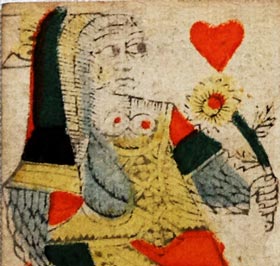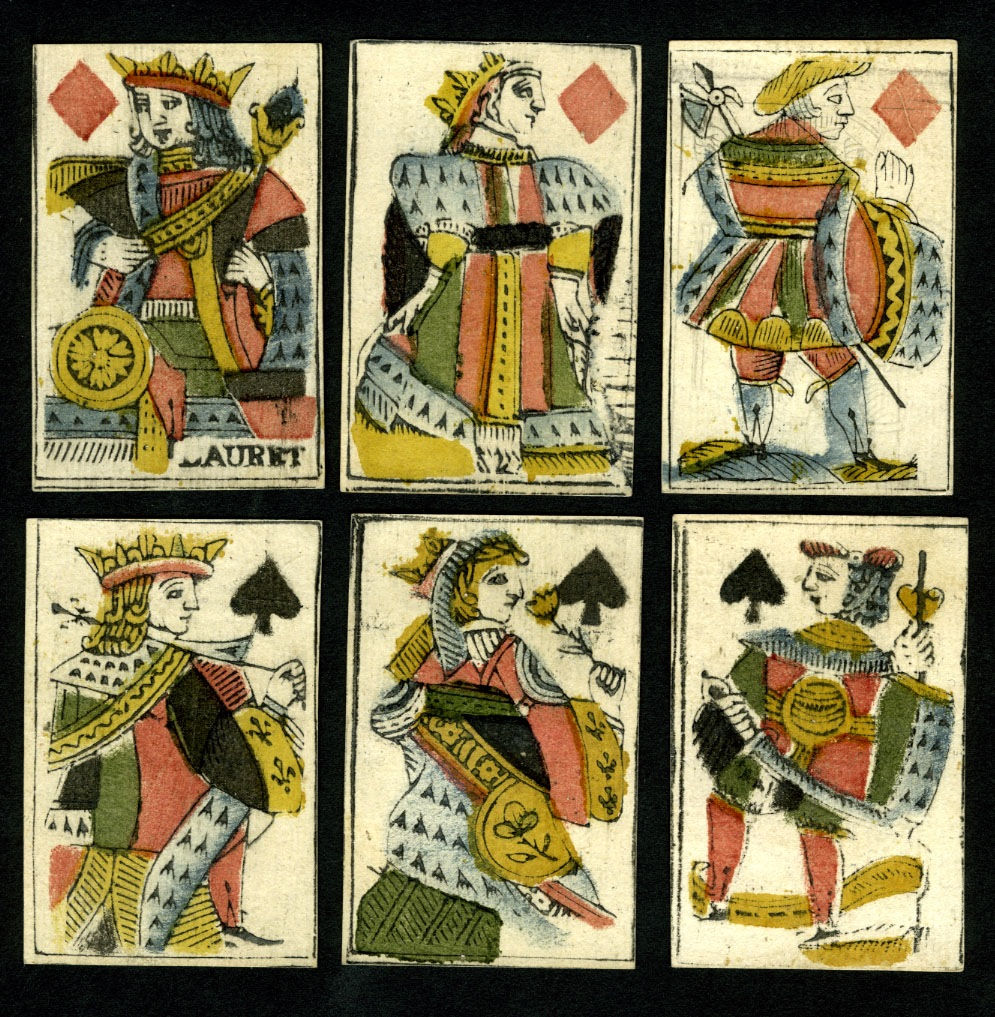Provence Pattern - Portrait de Provence
The 'Provence' pattern contains figures which go back to the fifteenth century.

Provence Pattern - Portrait de Provence
Ihe 'Provence' pattern has early origins and contains figures which go back to the fifteenth century. Cards produced in Lyon were exported to Provence, and also turn up in other regional patterns. For example, the king of clubs wields a battle axe (with a fleur-de-lys on the blade) and has been found as the king of coins in early Spanish or Italian-suited packs and has become the king of hearts in English packs (also known as the 'Suicide King').
The king of hearts has a crowned bird perching on his left hand. The king of diamonds holds en extremely thin sceptre, while the king of spades is in profile with his sceptre over his shoulder. The queen of hearts is a fur-covered 'Wild Woman' with bare feet. The queen of diamonds has large cylindrical shoulder sleeves and inscriptions down the sides. The other two queens hold flowers up to their noses. The two black-suited valets have plaited hair and hold banners showing the cardmaker's name. Unlike some other French patterns, the court cards in the Portrait de Provence are not named.

Above: Provence pattern by Dreveton c.1696. The Provence pattern was used in south-western France: Aix, Marseille, Toulon, Avignon, Nimes and Montpellier. Image source: d'Allemagne, Henry-René : Les cartes à jouer du XIVe au XXe siècle, Hachette et Cie, Paris, 1906, vol.1, p.119 ff


Above: cards of the archaic 'Provence' pattern made by Alexandre Lionet (or Lionnet), woodblock and stencil printing. There were several Lionets known in Montpellier, we are not sure when this one operated, but probably mid 18th century. The King of Hearts usually has a falcon on his wrist, but here there is a sunburst which also appears in the patterns on several other cards (see JH, QH & QS). The King and Jack of Diamonds (bottom right) appear to be substitutes from a different set as the colour palette is slightly different. The backs of the cards were originally plain white, and have been re-used as a lexicon of French grammar. Images courtesy Luc Esterson.
See also: Phelippe Ayet, c.1574 • Secondary Uses of Playing Cards→
Right: the backs of the cards have been used as a lexicon of French grammar (click to see more) →
6 cards from the Provence pattern, late 18th century

Above: 6 cards from the old 'Provence' pattern by Etienne Lauret, late 18th century. The Queen of Diamonds has distinctive squared shoulders but no inscription. Image courtesy Dan Dragojevich.

By Simon Wintle
Member since February 01, 1996
I am the founder of The World of Playing Cards (est. 1996), a website dedicated to the history, artistry and cultural significance of playing cards and tarot. Over the years I have researched various areas of the subject, acquired and traded collections and contributed as a committee member of the IPCS and graphics editor of The Playing-Card journal. Having lived in Chile, England, Wales, and now Spain, these experiences have shaped my work and passion for playing cards. Amongst my achievements is producing a limited-edition replica of a 17th-century English pack using woodblocks and stencils—a labour of love. Today, the World of Playing Cards is a global collaborative project, with my son Adam serving as the technical driving force behind its development. His innovative efforts have helped shape the site into the thriving hub it is today. You are warmly invited to become a contributor and share your enthusiasm.
Related Articles

Pathé Marconi
Special promotion pack for French record company Pathé Marconi.

Pierre Varangot
Tracing the origins, legality and legacy of Pierre Varangot’s San Sebastián deck.

Archaic Spanish-suited pattern from Bayonne
Archaic Franco-Spanish pattern from Bayonne by a manufacturer with the initals M.V.

Caisse Mutuelle d'Assurance et de Prevoyance
Insurance propaganda pack for Caisse Mutuelle d'Assurance et de Prevoyance with humorous artwork by ...

Jeu Révolutionnaire
Court cards and aces from a French Revolutionary pack by Pinaut, Paris, c.1794.

French Revolutionary cards by Pinaut
Seven cards from a French Revolutionary pack by Pinaut featuring characters from classical antiquity...

Never Mind the Belote
Limited edition Belote pack with designs by a collective of 24 street artists.

Sannois dans les étoiles
Celebrities and buildings associated with Sannois, a commune in the suburbs of Paris.

Le Globe Céleste
Views and plans of five international exhibitions held in Paris between 1855 and 1900.

Le Journal de Mickey
Perforated sheet of cards with Disney characters issued with the magazine Le Journal de Mickey.

Tarot hiéroglyphique égyptien
The design of the cards draws inspiration from various religious and philosophical traditions merged...

La Réussite (Sébastien Féraut)
Sébastien Féraut’s designs inspired by the animal kingdom for a set promoting patience games.

Le Tarot de Sète
Reinterpretation of the Tarot de Marseille by Julien Labat, an artist from Sète.

Oracle Rock
Cartomantic set depicting rock and pop stars, designed by La Rata, with a book by Virginie Despentes...

Jeu Numismatique
European coins of all periods replace the traditional courts and pips.

Jeu Philatélique
Cards with French postage stamps featuring famous literary figures.
Most Popular
Our top articles from the past 28 days

